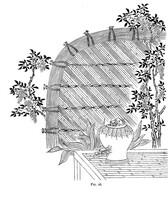THE Water Basin is found in all Japanese gardens, situated generally in close proximity to a building, but forming a part of the garden composition. Its purpose is to provide water for rinsing the hands, and it is therefore placed so as to be easily reached with a ladle from the gallery or verandah leading to the more private parts of the residence. As a screen between it and the wall of the neighbouring lavatory, a low ornamental fence of bamboo or rush-work is placed on one side, also a stone lantern half hidden by trees and shrubs; all of which are scrupulously kept free from dirt, webs, or insects. Fig. 16 illustrates one of the many designs of screens serving such a purpose. The size of a Water Basin should, strictly speaking, be proportionate to the character of the building, and its distance from the verandah should also accord with the general dimensions adopted. As the ordinary distance of a Basin from the outer gallery of a small residence is about eighteen inches, and its height from the ground about three or four feet, it follows that, in front of a building of large proportions, the Basin becomes at least four or five feet removed, and its height seven or eight feet from the soil. It is consequently out of reach for practical purposes, and in connection with religious and palatial buildings of large size and importance, in which due proportions are carefully followed, the large Water Basin becomes merely an ornament, another smaller Basin and draining floor, called Nure-En, attached to the verandah, being provided for service. Such large ornamental Basins, removed to a distance from the building and beyond the shelter of its projecting eaves, are provided with some kind of decorative lid or cover to keep out the rain.

